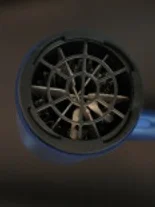Hair Shaft Damage: The Real Cost of a Hair Dryer
Last week, I was discussing hair dryers at a local salon. The salon had an astonishing array of models to choose from. Some models offered high heat, others a variety of speeds. Some were inexpensive, some were hundreds of dollars. How does one choose a hair dryer? It’s an important question – especially if someone already has hair damage.
The process by which hair dries is a complex and fascinating process. Water doesn’t simply evaporate from the hair that way water evaporates from city streets after a rainstorm. Instead, as water is removed from hair, many chemical bonds form and reform. As everyone knows, hair drying not only removes water from the hair, but helps style it as well. This is because of new chemical bonds that are formed.
Excessive heat can damage hair and hair damage is something that I see often among women. When I use the term hair damage, I’m really talking about damage to the hair fiber itself. Individuals with hair damage note that hair is easily broken. The hair loses its shine. The hair becomes less manageable. In some cases, hair shaft damage may even lead to hair loss.
For those individuals in whom I detect damaged hair, I advise using a hair dryer on a warm setting or locking the hair blower away for a period of time and only towel drying the hair. The use of a deep conditioner or leave in conditioner may also prove useful.
I can instantly spot hair damage. But knowing what causes hair damage can be a bigger challenge as hair damage can come from many sources. The way the hair is colored, dried, brushed and ultimately styled can potentially lead to hair shaft damage. An array of scalp problems and hair diseases can also cause hair shaft damage.
It’s incredible just how many types of hair dryers there are on the market. The biggest price we pay for using them incorrectly is hair shaft damage. Fortunately, for most individuals this damage is completely repairable and reversible when the problem is detected early. Many women in my hair loss practice are hesitant to change way they dry their hair. They want their hair dried quickly, and easily styled. If there is no hair shaft damage, I don’t advise changing anything. But for those with hair shaft damage due to heat, the heat must be reduced. At first it is challenging, but when they see improvements in manageability and shine and eventually hair density too – it becomes impossible to go back to previous ways.
This article was written by Dr. Jeff Donovan, a Canadian and US board certified dermatologist specializing exclusively in hair loss.


